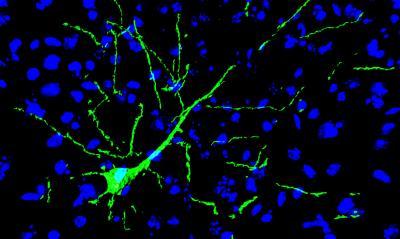Scientists have grafted neurons reprogrammed from skin cells into the brains of mice with long-term stability for the first time. Six months after implantation, the neurons had become fully functionally integrated into the brain.
That's equivalent to about 20 years in human terms. Successful, stable implantation of neurons raises hope for future therapies that will replace sick neurons with healthy ones in the brains of Parkinson's disease patients, for example.
Prof. Dr. Jens Schwamborn and Kathrin Hemmer of the Luxembourg Centre for Systems Biomedicine (LCSB) caution that the path towards successful therapy in humans is long.

Part of a brain slice in which a transplanted induced neural stem
cell is fully integrated in the neuronal network of the brain (blue)
to develop into a complex and functional neuron.
Credit: (c) LCSB 2014
"Successes in human therapy are still a long way off, but I am sure successful cell replacement therapies will exist in future. Our research results have taken us a step further in this direction," says Schwamborn.
In their latest tests, the research group and colleagues from the Max Planck Institute and the University Hospital Münster and the University of Bielefeld succeeded in creating stable nerve tissue in the brain from neurons that had been reprogrammed from skin cells. The stem cell researchers' technique of producing neurons, or more specifically induced neuronal stem cells (iNSC), in a petri dish from the host's own skin cells considerably improves the compatibility of the implanted cells.
The treated mice showed no adverse side effects even six months after implantation into the hippocampus and cortex regions of the brain. In fact it was quite the opposite – the implanted neurons were fully integrated into the complex network of the brain. The neurons exhibited normal activity and were connected to the original brain cells via newly formed synapses, the contact points between nerve cells.
The tests demonstrate that the scientists are continually gaining a better understanding of how to treat such cells in order to successfully replace damaged or dead tissue.
"Building upon the current insights, we will now be looking specifically at the type of neurons that die off in the brain of Parkinson's patients – namely the dopamine-producing neurons," Schwamborn reports.
In the future, implanted neurons could produce the lacking dopamine directly in the patient's brain and transport it to the appropriate sites - an actual cure. The first trials in mice are in progress at the LCSB laboratories on the university campus Belval.
Source: University of Luxembourg





Comments